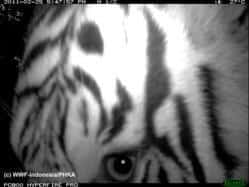Five of the seven wild cat species found on Indonesia’s Sumatra island were caught on camera traps in a single forest area during a recent World Wildlife Fund (WWF) survey, highlighting the urgent need to protect their forest habitat that is rapidly being cleared for industrial plantations.
Conducted in a forest of rich biodiversity known as Bukit Tigapuluh, or Thirty Hills, the WWF survey captured on camera the Sumatran tiger, Sunda clouded leopard, marble cat, Asian golden cat, and leopard cat. All of the wild cats were found in an unprotected forest corridor between the Bukit Tigapuluh forest landscape and the Rimbang Baling Wildlife sanctuary in Riau Province. The area is threatened by encroachment and forest clearance for industrial plantations.
“Four of these species are protected by Indonesian Government regulations and are listed as threatened by extinction on the IUCN Red List,” said Karmila Parakkasi, Coordinator of the WWF-Indonesia Tiger Research Team. “This underscores the rich biodiversity of the Bukit Tigapuluh landscape and the forest corridors that connect to it. These amazing cat photos also remind us of how much we could lose as more of these fragile forests are lost to logging, plantations and illegal encroachment.”
During a three month systematic sampling in the forest corridor this year, the camera trapping resulted in 404 photos of wild cats, including 226 of Sumatran tigers, 77 of Sunda clouded leopards, 70 of Asian golden cats, 4 of marbled cats, and 27 of leopard cats. The photos come on the heels of video footage WWF captured in May 2011 of three young tiger siblings playfully chasing a leaf. That footage was taken in the same area of the current batch of wild cat photos.
”Unfortunately much of the natural forest area in the landscape is threatened by large scale clearance for industrial logging, pulp and paper, as well as illegal encroachment for palm oil plantation development,” said Aditya Bayunanda WWF-Indonesia’s Coordinator for the Global Forest Trade Network Programme.
“The abundant evidence of these five wild cat species suggests that the concession licenses of companies operating in these areas, such as Barito Pacific, should be reviewed and adjusted according to Indonesian Ministry regulations, which state that concession areas with the presence of endangered species should be protected by the concessionaire.
WWF-Indonesia has also called on protection for areas bordering Bukit Tigapuluh National Park, either by expanding the park or managing it under the current forest ecosystem restoration scheme,” he continued.
At a November 2nd, 2011 WWF event in Jakarta, Indonesian Minister of Forestry Zulkifli Hasan publicly stated his support for issuing a license for a forest ecosystem restoration program in Bukit Tigapuluh. Bukit Tigapuluh is designated a “global priority Tiger Conservation Landscape” and is one of six landscapes the government of Indonesia pledged to protect at last year’s International Tiger Forum, or Tiger Summit, of world leaders in St. Petersburg, Russia.
Photos of the five wild cat species to illustrate the press release above can be downloaded at the following link, http://www.mediafire.com/?m6pwh9fiuqp73nn and mentioning copyright by WWF-Indonesia/PHKA
Video footage of WWF Tiger team survey and an interview with Karmila Parakkasi in Bukit Tigapuluh landscape can be downloaded at http://gvn.panda.org/pages/view.php?ref=3194&k=8d70aa7e55
Video trap footage of the three young tiger siblings published in May 2011 can be downloaded at http://gvn.panda.org/pages/view.php?ref=3138&k=d4fe799aad and relevant photos can be downloaded at http://www.mediafire.com/?luly4a8fd15ajoa


